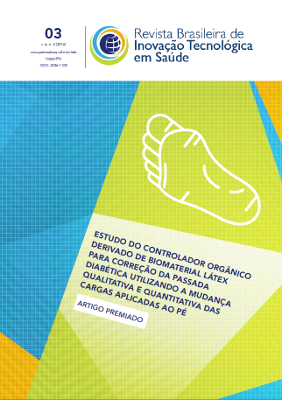Estudo do controlador orgânico derivado de biomaterial látex para correção da passada diabética utilizando a mudança qualitativa e quantitativa das cargas aplicadas ao pé
DOI:
https://doi.org/10.18816/r-bits.v6i3.10101Resumo
Este trabalho apresenta o desenvolvimento e a inserção de um elemento externo denominado Diabets Ground Control (DGC) com base na etiologia mecânica do problema e avalia a variação das variáveis principais do sistema. O objetivo deste trabalho é propor um controlador para que por meio da mudança qualitativa e quantitativa das cargas aplicadas ao pé seja possível a correção da passada diabética. Essa interação controlada entre o pé diabético e o controlador é o que os autores defendem como a teoria de Controle Orgânico. Para obter o modelo matemático será usada a ferramenta Bond Graph (BG), um método alternativo as práticas clássicas de modelagem existentes introduzido por Paynter em 1961. Essa metodologia é fundamental para a concepção de uma teoria bio inspirada na área de Engenharia Biomédica, a teoria de Controle Orgânico. Dessa forma, a palmilha DGC permitirá a redistribuição da carga por toda a extensão da planta do pé sempre interagindo diretamente na resposta do sistemaDownloads
Referências
Mueller MJ, Minor SD, Sahrmann SA, et al. Differences in the gait characteristics of patients with diabetes and penpheral neuropathy compared with age-matched controls. Phys Ther. 1994; 74:299-313.1
Diabetes. [http://www.who.int/mediacentre/factsheets/fs312/en/].
Reaz M, Hussain M, Mohd-Yasin F: Techniques of EMG signal analysis: detection, processing, classification and applications (Correction). Biol Proced Online 2006, 8:163–163.
Soysa et al.: Importance and challenges of measuring intrinsic foot muscle strength. Journal of Foot and Ankle Research 2012, 5:29. doi:10.1186/1757-1146-5-29
Sartor et al.: Effects of a combined strengthening,stretching and functional training program versus usual-care on gait biomechanics and foot function for diabetic neuropathy: a randomized controlled trial. BMC Musculoskeletal Disorders 2012 13:36. doi:10.1186/1471-2474-13-36
Fregonesi CEPT; Camargo MR, Gait parameters in patients with diabetes mellitus. Rev. Bras. Cineantropom Desempenho Humano 2010, 12(2):155-163.
Cavanagh PR, Ulbrecht JS: Biomechanics of the diabetic foot: a quantitative approach to the assessment of neuropathy, deformity and plantar pressure Philadelphia: W.B. Saunders; 1991.
Rao S, Saltzman CL, Yack HJ: Relationships between segmental foot mobility and plantar loading in individuals with and without diabetes and neuropathy. Gait Posture 2010, 31(2):251-255.
Bus SA, Maas M, Michels RP, Levi M: Role of intrinsic muscle atrophy in the etiology of claw toe deformity in diabetic neuropathy may not be as straightforward as widely believed. Diabetes Care 2009, 32(6):1063-1067.
Rodgers MM: Dynamic foot biomechanics. J Orthop Sports Phys Ther 1995, 21(6):306-316.
Sacco IC, Bacarin TA, Canettieri MG, Hennig EM: Plantar Pressures During Shod Gait in Diabetic Neuropathic Patients with and without a History of Plantar Ulceration. J Am Podiatr Med Assoc 2009, 99(4):285-294.
James S. Wrobel, D.P.M., M.S., and Bijan Najafi, Ph.D., M.S. Diabetic Foot Biomechanics and Gait Dysfunction Journal of Diabetes Science and Technology Volume 4, Issue 4, July 2010, 833;845.
Richardson JK, Thies SB, DeMott TK, Ashton-Miller JA. Gait analysis in a challenging environmental differentiates between fallers and nonfallers among older patients with peripheral neuropathy. Arch Phys Med
Rehabil 2005;86(8):1539-1544.
Yavuz M, Botek G, Davis BL. Plantar shear stress distributions: comparing actual and predicted frictional forces at the foot-ground interface. J Biomech. 2007;40(13):3045-9.
Stucke S, McFarland D, Goss L, Fonov S, McMillan GR, Tucker A, Berme N, Guler HC, Bigelow C, and Davis BL, Spatial relationships between shearing stresses and pressure on the plantar skin surface during gait. Biomech. 2012 February 2; 45(3): 619–622. doi:10.1016/j.jbiomech.2011.11.004.
Sawacha Z, Gabriella G, Cristoferi G, Guiotto A, Avogaro A, Cobelli C. Diabetic gait and posture
abnormalities: A biomechanical investigation through three dimensional gait analysis. Clin Biomech (Bristol, Avon). 2009; 24:722–728.
Sinacore DR, Bohnert KL, Hastings M, Johnson JE. Mid foot kinetics characterize structural polymorphism in diabetic foot disease. Clinical Biomechanics. 2008;23:653-61.
Turner DE, Helliwell PS, Burton AK, Woodburn J. The relationship between passive range of motion and range of motion during gait and plantar pressure measurements. Diabet Med. 2007;24:1240-6.
Guldemond NA, Leffers P, Schaper NC, Sanders AP, Nieman F, Willems P, Walenkamp GHIM. The effects of insole configurations on forefoot plantar pressure and walking convenience in diabetic patients with
neuropathic feet. Clin Biomech 2007;22(1):81-87.
Hsi WL, Chai HM, Lai JS. Evaluation of rocker sole by pressure-time curves in insensate forefoot during gait. Am J Phys Med Rehabil 2004;83(7):500-5-6.
Raspovic et al.: Reduction of peak plantar pressure in people with diabetes-related peripheral neuropathy: an evaluation of the DH Pressure Relief Shoe™. Journal of Foot and Ankle Research 2012 5:25.
Piaggesi A, Macchiarini S, Rizzo L, Palumbo F, Tedeschi A, Nobili LA, Leporati E, Scire V, Teobaldi I, Del Prato S: An off-the-shelf instant contact casting device for the management of diabetic foot ulcers. Diabetes Care 2007, 30(3):586–590.
Hennessy K, Burns J, Penkala S: Reducing plantar pressure in rheumatoid arthritis: A comparison of running versus off-the-shelf orthopaedic footwear. Clin Biomech (Bristol, Avon) 2007, 22(8):917–923.]
Pai S, and Ledoux WR, PhD The shear mechanical properties of diabetic and non-diabetic plantar soft tissue J Biomech. 2012 January 10; 45(2): 364–370. doi:10.1016/j.jbiomech.2011.10.021.
Carter SE, Richardson JK, Thies S, DeMott T, Ashton-Miller JA. The relationship between frontal plane gait variability and ankle range of motion in older persons with neuropathy. Am J Phys Med Rehabil. 2009 March ; 88(3): 210–215. doi:10.1097/PHM.0b013e318194fb3c.
Russell KH; Bradley J R. Intermediate Physics for Medicine and Biology, Fourth Edition, ISBN-10: 0-387-30942-X e-ISBN-10: 0-387-49885-0; 2007 Springer Science pg. 543.
Paynter H. An epistemic prehistory of Bond Graphs. In P. Breedveld and G. Dauphin-Tanguy, Eds., Bond Graphs for Engineers. Amsterdam: North-Holland, 1992, pp. 3–17.








 Português (Brasil)
Português (Brasil) English
English Español (España)
Español (España)






